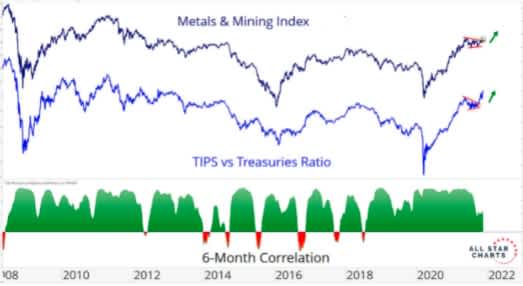Anxious about inflation? Have you ever considered the mining sector?

Keytrade Bank
keytradebank.be
December 10, 2021
(updated January 24, 2022)
3 minutes to read
Higher inflation figures are keeping investors up at night. Not only do they evoke unpleasant memories of the 1970s, but they can prove to be the kiss of death for your purchasing power. After all, what else are you investing for, if not to guarantee your future purchasing power? Given the current stock market climate, we believe investing in a diversified basket of mining shares is a good alternative to hedge against inflation – if you haven't considered this strategy already.
Inflation is a hot topic in the financial and economic press, with instruments offering a hedge against inflation receiving extensive coverage wherever you look. Inflation-linked bonds in particular tend to be the main focus at present.
How does an inflation-linked bond work, and what makes it different from a conventional bond?
If you invest €1,000 in a conventional bond, you receive your coupon and €1,000 on the bond's maturity date each year. However, if inflation rises during the bond's term, you will not be able to purchase as much with the €1,000 compared to when you originally invested in the bond.
This issue can be avoided with inflation-linked bonds, as the value of an inflation-linked bond at maturity tracks changes in inflation. Say you invest €1,000 in a bond with an annual coupon of 2%. If inflation has risen above 3% at one of the key moments specified in advance, your bond's value will increase to €1,030. The index is also applied to the interest rate, meaning that the coupon stands at €20.60.
However, one disadvantage of inflation-linked bonds is that they have a lower initial interest rate to start with, which means this hedging comes at a cost. They become more attractive when real inflation is higher than expected during the bond's term. This may well be why they have received a lot of backing in recent times.
Are there any alternatives?
Figure 1 presents one. At the top, we can see the trend in the Metals and Mining Index, which includes one of the largest aluminium manufacturers (Alcoa) and copper manufacturers (Freeport-McMoRan).
Below the mining index, we can see the relative performance of TIPS (Treasury Inflation-Protected Securities) – US inflation-linked bonds – compared to US government bonds (Treasuries). The graph at the bottom shows the six-month correlation between the two lines.
Both lines are almost identical, showing high correlation. This means that active funds in mining shares or trackers following this sector are a worthwhile alternative to hedge against inflation.
The graph also shows that TIPS have strongly outperformed Treasuries since 2020 – a sign that bond investors are prioritising the purchase of TIPS. The situation is identical in Europe, too.
Figure 1: Mining Companies vs TIPS/Treasuries

Source: All Star Charts
Conclusion
Anyone feeling uneasy about higher inflation rates worldwide can opt for inflation-linked bonds. However, those who prefer to stay in shares or trackers can opt for an investment in a diversified active or passive fund that invests in mining shares.
The choice is yours.
Geert Van Herck Chief Strategist KEYPRIVATE


